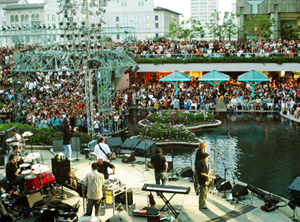City sounds
Anthropologist Marina Peterson analyzed, and performed in, a Los Angeles outdoor music series.
By Brooke E. O’Neill, AM’04
Photography by Guilherme Grund-Rafols

Los Angeles's summer music series Grand Performances brings a sprawling city together.
As evening falls over downtown Los Angeles, music fills the air at California Plaza. Onstage, a conductor leads about 60 musicians through warm-up chords. Marina Peterson, AB’98, AM’00, PhD’05, pulls a bow across her cello’s strings, tuning her instrument to the piano. Suddenly a horn belts out a jazz lick. A few DJs join in, tapping low, steady beats on their drum machines. The group, daKAH Hip Hop Orchestra, is part of Grand Performances, a free summer world-music series in Los Angeles. An ensemble that fuses classical styles with hip-hop, funk, and jazz, daKAH is known for getting audiences on their feet.
For Peterson, playing with the group in 2003 was more than a gig. An anthropologist who teaches performance studies at Ohio University, she had spent the previous two summers in Los Angeles analyzing the role of free public concerts in contemporary urban life. With Grand Performances as her focal point, she investigated the possibilities—and limitations—of citywide musical programming. In her 2010 book Sound, Space, and the City: Civic Performance in Downtown Los Angeles (University of Pennsylvania Press), Peterson argues that public music performances offer a unique form of civic participation, creating a space where a diverse, often disconnected city can come together in harmony.
As cities around the world seek to revitalize their downtowns, often through public concerts and the arts, Grand Performances provides a case study for urban planners. Civic performances can be a way of “sounding the city,” consciously reflecting and creating the urban environment through sound and space, says Peterson, who studied Grand Performances for her doctoral fieldwork. Now approaching its 25th season, featuring dozens of performances, the series has drawn crowds in the thousands, spanning ages, races, and ethnicities. That’s no small feat in Los Angeles, a city often maligned for its decentralized sprawl of neighborhoods.
For Chicagoans who attend free concerts at the Chicago Cultural Center, Millennium Park, or other downtown venues, such an organization seems a natural part of city life. In Chicago, Peterson explains, “it is taken for granted that people from around the city will come to downtown concerts and experience them as a civic body.” That mind-set parallels the Chicago School of Sociology, which considers the Windy City the quintessential urban model: a vibrant downtown with neighborhoods radiating outward, the center magnet pulling in citizens and fueling civic life.
Los Angeles lacks that powerful center. Instead, Peterson argues, Grand Performances attracts its broad audience by featuring performers who reflect the city’s multicultural identity. The series has offered Latin jazz, Chinese contemporary dance, Latvian folk, Afro-pop, mariachi, and other international genres.
As a physical, sensory experience, music can foster a sense of unity in a way no town-hall meeting can, says Peterson. As one audience member put it, a public concert “encourages people from all walks of life to share joy.” At the daKAH performance where Peterson played, teens, 20-somethings, and middle-aged couples of multiple races and ethnicities danced together in the plaza space. That communal act of moving to the same beat, she says, lets people know they’re in harmony with each other and gives Angelenos a vision of their city, idealized.
Onstage, Peterson and the other performers danced along in their seats. “Having that kinesthetic experience is really an important part of music research,” says Peterson, who earned a performer’s certificate from Northern Illinois University and trained with cellist Marc Johnson of the three-time Grammy-nominated Vermeer Quartet. After seeing daKAH at Grand Performances in 2002, she contacted Geoff “Double G” Gallegos, the group’s conductor, who invited her to perform the following summer. “Here was a chance to be part of this sound, this experience,” she recalls.
Not everyone can be part of the experience. Creating an inclusive community often means excluding some individuals. During concerts, security guards monitor those who appear visibly homeless and ask them to leave, says Peterson, “for fear that they will drive part of the diverse, middle-class audience away.” Grand Performances, she argues, focuses on “bringing the ‘right’ people to California Plaza, who will help constitute a multicultural audience but not make class apparent.” That stipulation, she says, reveals a contradiction in the organization’s message of tolerance.
The possibilities and tensions inherent in public concerts provide a window into life in contemporary cities, says Peterson, who is now coediting Global Downtowns (University of Pennsylvania Press, forthcoming), an overview of downtown renewal efforts from Havana to Zanzibar.
Meanwhile she continues to explore the potential of sound in her own experimental music, finding new ways to play the cello. She has put paper under the strings, for example, to create music ranging from “scratchy to fluttery.” She performs about once a month, mostly in art galleries and in venues like Chicago’s Brown Rice, traveling from her home in southeast Ohio. At once urban research and concert, these performances are her own personal way of sounding the city.
